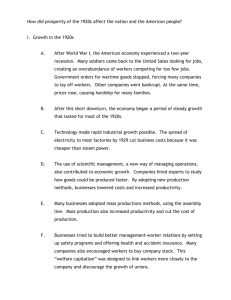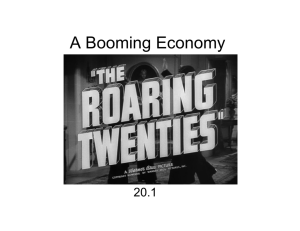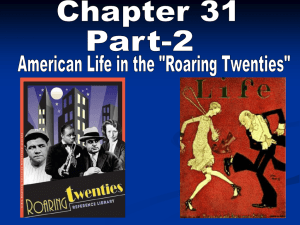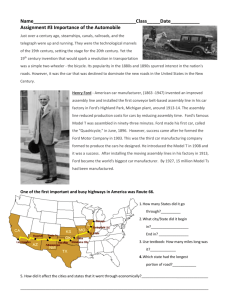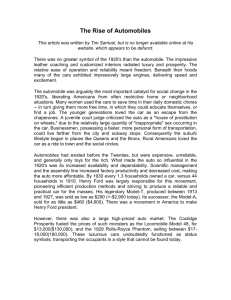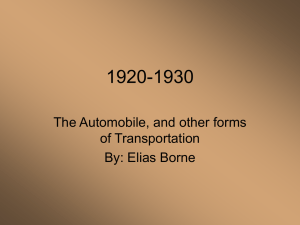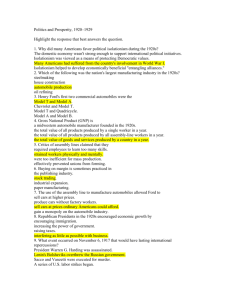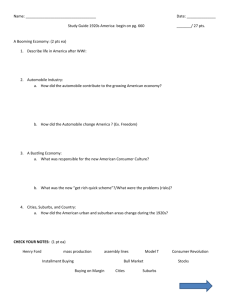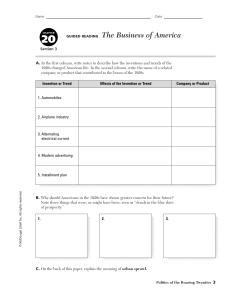World War I and its Aftermath
advertisement
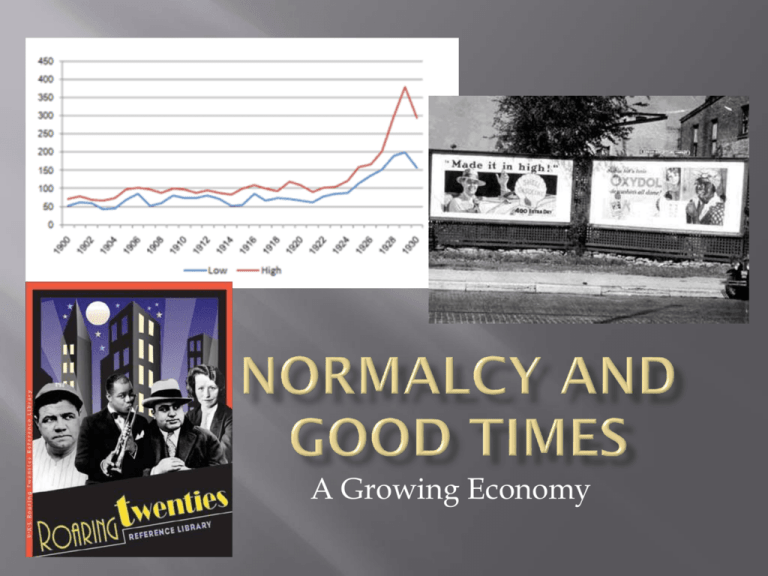
A Growing Economy By the end of this lesson you will: Describe an assembly line. Tell what tradition International Harvester started. State what Ford’s Sociological Department was created to do. Understand Ford’s philosophy towards increasing sales. Describe how the automobile affected American business and society in the 1920s. Know how most Americans felt about the airplane. Know how Charles Lindberg changed how Americans felt about the airplane. Understand welfare capitalism. Mass Production: large-scale product manufacturing usually done by machinery Created more supply Reduced consumer cost The Assembly Line: divided operations into simple tasks that unskilled workers could perform and cut unnecessary motion to a minimum Henry Ford’s philosophy was to lower the price of the car In 1912 a car took 12 hours to build and it cost $850 In 1925 a car was finished every 10 seconds and cost $295! The automobile became available to millions of Americans. The car created new enterprises such as garages and gas stations. Rural life was less isolated. People could now commute greater distances to work. International Harvester Maker of trucks, tractors, and other farm machinery Instituted an annual two-week paid vacation for employees Ford Motor Company Began a sociological department to set requirements workers had to meet Many new goods and products became available to Americans who had “disposable” income (extramoney): Electric Razors Disposable facial tissue Frozen food Home hair dye Cleaning products (spurred by indoor plumbing) Electric Irons Vacuum Cleaners Washing Machines Refrigerators Gas Stoves Improved Glass Cookware Fashion Personal Appearance Items Did not “take off” as fast as the automobile industry People thought airplanes were flimsy, unsafe, and just a novelty Starting in 1918 the USPS used airplanes to fly mail between Washington DC and New York. The Air Commerce Act: offered federal aid to build airports In 1927 Charles Lindbergh flew solo across the Atlantic boosting the airline industry. By 1928, 48 airlines flew to 355 US cities regularly. 1926-National Broadcasting Company (NBC) 1927-Columbia Broadcasting System (CBS) The 1928 Presidential Election Campaign was aired on the radio for the first time nationwide. Americans shifted from “thrift” and “prudence” to consumerism Easy Consumer Credit Individuals borrowed money to “get it now and pay for it later” Mass Advertising The Managerial Revolution Welfare Capitalism: Companies allowed workers to buy stock, participate in profit sharing, and receive benefits such as medical care and pensions. Unions seemed unnecessary. Workplaces where employees were hired without having to join a union became known as “open shops”. Farmers earned less than 1/3 of the average worker. ($333 dollars a year compared to $999) During the war farmers were encouraged to grow more for the war effort. Afterwards there was a surplus of crops driving the prices down. The Fordney-McCumber Act raised tariffs which made it difficult for farmers to sell products overseas. To try and help farmers, congress passed the McNary-Haugen Act twice. President Coolidge vetoed the act both times. How does an assembly line work? What tradition did International Harvester start? What was Ford’s Sociological Department created to do? What was Ford’s philosophy towards increasing sales? How did most Americans feel about the airplane? How did Charles Lindberg change how Americans felt about the airplane? What was welfare capitalism? How did the automobile affect American business and society in the 1920s? How did the automobile affect American business and society in the 1920s? Cars revolutionized American life. The auto industry spurred growth in other large industries, such as rubber, plate glass, nickel, and lead. Automaking alone consumed 15 percent of the nation’s steel, and the flood of cars stimulated a tremendous expansion of the petroleum industry. Cars also created new small-business opportunities, such as garages and gas stations. Cars eased the isolation of rural life, putting towns within reach of many farmers and the countryside a mere ride away for city dwellers. Cars also enabled people to live farther away from work. An entirely new kind of consumer and worker, the auto commuter, appeared. Commuters lived in growing suburban communities and drove to work in the city.
